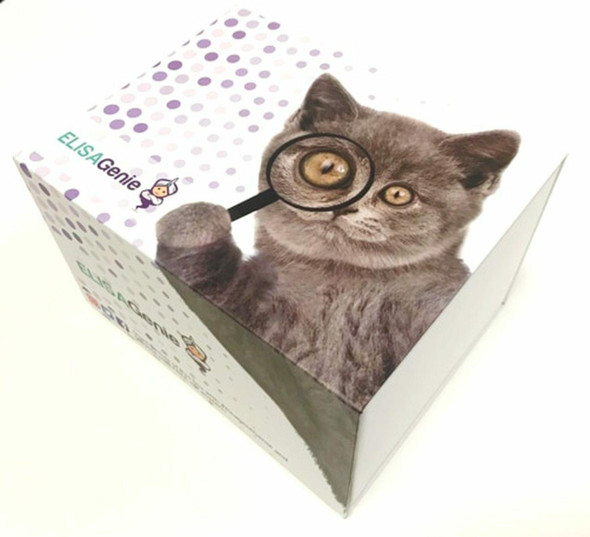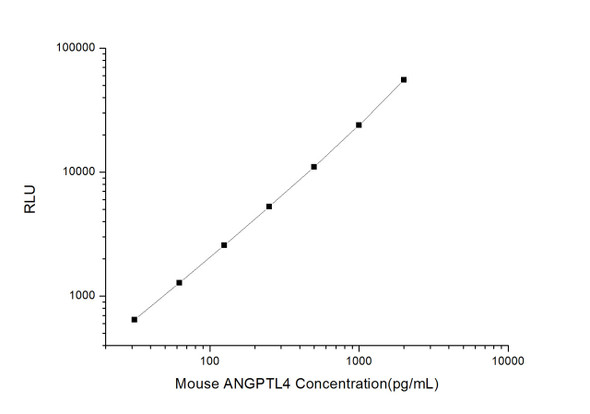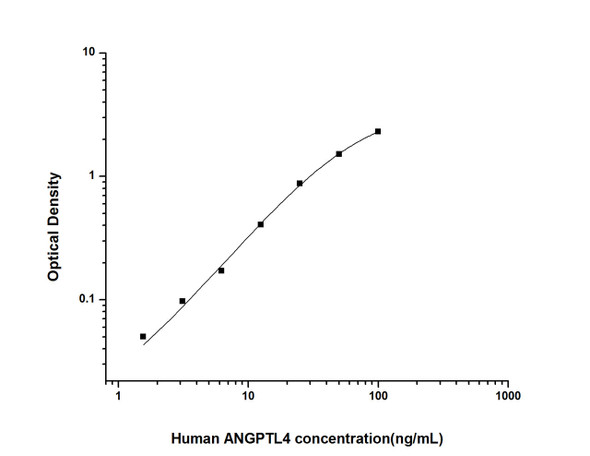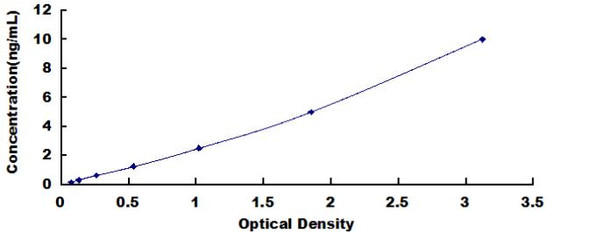Human Cardiovascular ELISA Kits
Human ANGPTL4 (Angiopoietin Like Protein 4) CLIA Kit (HUES00239)
- SKU:
- HUES00239
- Product Type:
- ELISA Kit
- ELISA Type:
- CLIA Kit
- Size:
- 96 Assays
- Sensitivity:
- 0.19ng/mL
- Range:
- 0.31-20ng/mL
- ELISA Type:
- Sandwich
- Synonyms:
- ARP4, FIAF, HFARP, NL2, PGAR, pp1158, Fasting-Induced Adipose Factor
- Reactivity:
- Human
- Sample Type:
- Serum, plasma and other biological fluids
- Research Area:
- Cardiovascular
Description
| Assay type: | Sandwich |
| Format: | 96T |
| Assay time: | 4.5h |
| Reactivity: | Human |
| Detection method: | Chemiluminescence |
| Detection range: | 0.31-20 ng/mL |
| Sensitivity: | 0.19 ng/mL |
| Sample volume: | 100µL |
| Sample type: | Serum, plasma and other biological fluids |
| Repeatability: | CV < 15% |
| Specificity: | This kit recognizes Human ANGPTL4 in samples. No significant cross-reactivity or interference between Human ANGPTL4 and analogues was observed. |
This kit uses Sandwich-CLIA as the method. The micro CLIA plate provided in this kit has been pre-coated with an antibody specific to Human ANGPTL4. Standards or samples are added to the appropriate micro CLIA plate wells and combined with the specific antibody. Then a biotinylated detection antibody specific for Human ANGPTL4 and Avidin-Horseradish Peroxidase (HRP) conjugate are added to each micro plate well successively and incubated. Free components are washed away. The substrate solution is added to each well. Only those wells that contain Human ANGPTL4, biotinylated detection antibody and Avidin-HRP conjugate will appear fluorescence. The Relative light unit (RLU) value is measured spectrophotometrically by the Chemiluminescence immunoassay analyzer. The RLU value is positively associated with the concentration of Human ANGPTL4. The concentration of Human ANGPTL4 in the samples can be calculated by comparing the RLU of the samples to the standard curve.
| UniProt Protein Function: | ANGPTL4: Protein with hypoxia-induced expression in endothelial cells. May act as a regulator of angiogenesis and modulate tumorigenesis. Inhibits proliferation, migration, and tubule formation of endothelial cells and reduces vascular leakage. May exert a protective function on endothelial cells through an endocrine action. It is directly involved in regulating glucose homeostasis, lipid metabolism, and insulin sensitivity. In response to hypoxia, the unprocessed form of the protein accumulates in the subendothelial extracellular matrix (ECM). The matrix-associated and immobilized unprocessed form limits the formation of actin stress fibers and focal contacts in the adhering endothelial cells and inhibits their adhesion. It also decreases motility of endothelial cells and inhibits the sprouting and tube formation. |
| UniProt Protein Details: | Protein type:Inhibitor; Apoptosis; Secreted, signal peptide; Secreted; Extracellular matrix Chromosomal Location of Human Ortholog: 19p13. 3 Cellular Component: proteinaceous extracellular matrix; extracellular space; extracellular region Molecular Function:enzyme inhibitor activity; protein binding Biological Process: positive regulation of angiogenesis; response to hypoxia; negative regulation of lipoprotein lipase activity; cellular lipid metabolic process; angiogenesis; cell differentiation; protein homooligomerization; negative regulation of apoptosis Disease: Plasma Triglyceride Level Quantitative Trait Locus |
| NCBI Summary: | This gene encodes a glycosylated, secreted protein containing a C-terminal fibrinogen domain. The encoded protein is induced by peroxisome proliferation activators and functions as a serum hormone that regulates glucose homeostasis, lipid metabolism, and insulin sensitivity. This protein can also act as an apoptosis survival factor for vascular endothelial cells and can prevent metastasis by inhibiting vascular growth and tumor cell invasion. The C-terminal domain may be proteolytically-cleaved from the full-length secreted protein. Decreased expression of this gene has been associated with type 2 diabetes. Alternative splicing results in multiple transcript variants. This gene was previously referred to as ANGPTL2 but has been renamed ANGPTL4. [provided by RefSeq, Sep 2013] |
| UniProt Code: | Q9BY76 |
| NCBI GenInfo Identifier: | 25008123 |
| NCBI Gene ID: | 51129 |
| NCBI Accession: | Q9BY76. 2 |
| UniProt Secondary Accession: | Q9BY76,Q53HQ6, Q53HU1, Q6UXN0, Q9HBV4, Q9NZU4, Q9Y5B3 A8MY84, B4E089, D6W670, F5H0I2, |
| UniProt Related Accession: | Q9BY76 |
| Molecular Weight: | 26,853 Da |
| NCBI Full Name: | Angiopoietin-related protein 4 |
| NCBI Synonym Full Names: | angiopoietin-like 4 |
| NCBI Official Symbol: | ANGPTL4 |
| NCBI Official Synonym Symbols: | NL2; ARP4; FIAF; HARP; PGAR; HFARP; TGQTL; UNQ171; pp1158; ANGPTL2 |
| NCBI Protein Information: | angiopoietin-related protein 4; fasting-induced adipose factor; PPARG angiopoietin related protein; hepatic angiopoietin-related protein; hepatic fibrinogen/angiopoietin-related protein; peroxisome proliferator-activated receptor (PPAR) gamma induced angiopoietin-related protein |
| UniProt Protein Name: | Angiopoietin-related protein 4 |
| UniProt Synonym Protein Names: | Angiopoietin-like protein 4; Hepatic fibrinogen/angiopoietin-related protein; HFARP |
| Protein Family: | Angiopoietin-related protein |
| UniProt Gene Name: | ANGPTL4 |
| UniProt Entry Name: | ANGL4_HUMAN |
As the RLU values of the standard curve may vary according to the conditions of the actual assay performance (e. g. operator, pipetting technique, washing technique or temperature effects), the operator should establish a standard curve for each test. Typical standard curve and data is provided below for reference only.
| Concentration (ng/mL) | RLU | Average | Corrected |
| 20 | 33421 34543 | 33982 | 33950 |
| 10 | 11655 13285 | 12470 | 12438 |
| 5 | 5526 4974 | 5250 | 5218 |
| 2.5 | 2458 2590 | 2524 | 2492 |
| 1.25 | 1443 1323 | 1383 | 1351 |
| 0.63 | 933 801 | 867 | 835 |
| 0.31 | 623 623 | 623 | 591 |
| 0 | 31 33 | 32 | -- |
Precision
Intra-assay Precision (Precision within an assay): 3 samples with low, mid range and high level Human ANGPTL4 were tested 20 times on one plate, respectively.
Inter-assay Precision (Precision between assays): 3 samples with low, mid range and high level Human ANGPTL4 were tested on 3 different plates, 20 replicates in each plate.
| Intra-assay Precision | Inter-assay Precision | |||||
| Sample | 1 | 2 | 3 | 1 | 2 | 3 |
| n | 20 | 20 | 20 | 20 | 20 | 20 |
| Mean (ng/mL) | 1.10 | 1.96 | 7.25 | 0.99 | 2.01 | 7.60 |
| Standard deviation | 0.14 | 0.23 | 0.68 | 0.11 | 0.18 | 0.49 |
| C V (%) | 12.73 | 11.73 | 9.38 | 11.11 | 8.96 | 6.45 |
Recovery
The recovery of Human ANGPTL4 spiked at three different levels in samples throughout the range of the assay was evaluated in various matrices.
| Sample Type | Range (%) | Average Recovery (%) |
| Serum (n=5) | 94-107 | 99 |
| EDTA plasma (n=5) | 88-99 | 93 |
| Cell culture media (n=5) | 95-108 | 102 |
Linearity
Samples were spiked with high concentrations of Human ANGPTL4 and diluted with Reference Standard & Sample Diluent to produce samples with values within the range of the assay.
| Serum (n=5) | EDTA plasma (n=5) | Cell culture media (n=5) | ||
| 1:2 | Range (%) | 87-101 | 86-98 | 95-112 |
| Average (%) | 92 | 91 | 102 | |
| 1:4 | Range (%) | 99-115 | 89-99 | 87-99 |
| Average (%) | 106 | 94 | 93 | |
| 1:8 | Range (%) | 95-110 | 87-101 | 94-111 |
| Average (%) | 102 | 93 | 101 | |
| 1:16 | Range (%) | 99-115 | 100-114 | 99-116 |
| Average (%) | 105 | 108 | 107 |
An unopened kit can be stored at 4°C for 1 month. If the kit is not used within 1 month, store the items separately according to the following conditions once the kit is received.
| Item | Specifications | Storage |
| Micro CLIA Plate(Dismountable) | 8 wells ×12 strips | -20°C, 6 months |
| Reference Standard | 2 vials | |
| Concentrated Biotinylated Detection Ab (100×) | 1 vial, 120 µL | |
| Concentrated HRP Conjugate (100×) | 1 vial, 120 µL | -20°C(shading light), 6 months |
| Reference Standard & Sample Diluent | 1 vial, 20 mL | 4°C, 6 months |
| Biotinylated Detection Ab Diluent | 1 vial, 14 mL | |
| HRP Conjugate Diluent | 1 vial, 14 mL | |
| Concentrated Wash Buffer (25×) | 1 vial, 30 mL | |
| Substrate Reagent A | 1 vial, 5 mL | 4°C (shading light) |
| Substrate Reagent B | 1 vial, 5 mL | 4°C (shading light) |
| Plate Sealer | 5 pieces | |
| Product Description | 1 copy | |
| Certificate of Analysis | 1 copy |
- Set standard, test sample and control (zero) wells on the pre-coated plate and record theirpositions. It is recommended to measure each standard and sample in duplicate. Note: addall solutions to the bottom of the plate wells while avoiding contact with the well walls. Ensuresolutions do not foam when adding to the wells.
- Aliquot 100µl of standard solutions into the standard wells.
- Add 100µl of Sample / Standard dilution buffer into the control (zero) well.
- Add 100µl of properly diluted sample (serum, plasma, tissue homogenates and otherbiological fluids. ) into test sample wells.
- Cover the plate with the sealer provided in the kit and incubate for 90 min at 37°C.
- Aspirate the liquid from each well, do not wash. Immediately add 100µL of BiotinylatedDetection Ab working solution to each well. Cover the plate with a plate seal and gently mix. Incubate for 1 hour at 37°C.
- Aspirate or decant the solution from the plate and add 350µL of wash buffer to each welland incubate for 1-2 minutes at room temperature. Aspirate the solution from each well andclap the plate on absorbent filter paper to dry. Repeat this process 3 times. Note: a microplatewasher can be used in this step and other wash steps.
- Add 100µL of HRP Conjugate working solution to each well. Cover with a plate seal andincubate for 30 min at 37°C.
- Aspirate or decant the solution from each well. Repeat the wash process for five times asconducted in step 7.
- Add 100µL of Substrate mixture solution to each well. Cover with a new plate seal andincubate for no more than 5 min at 37°C. Protect the plate from light.
- Determine the RLU value of each well immediately.






